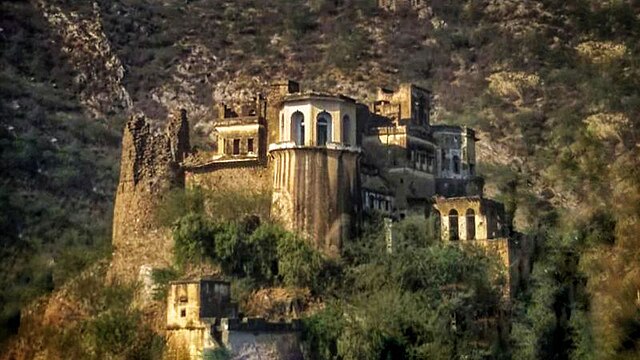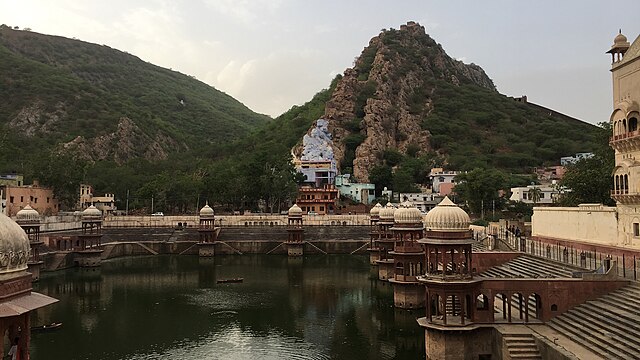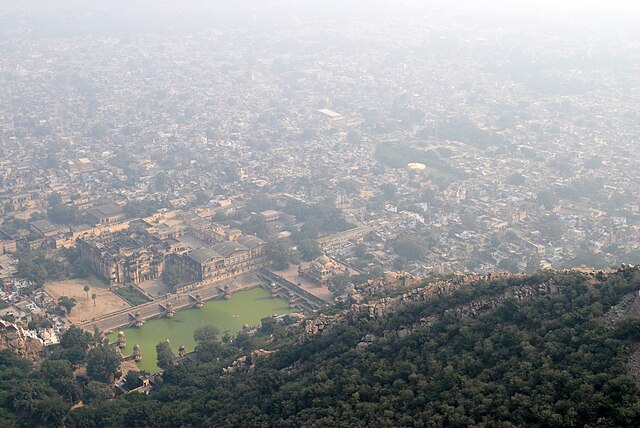Tucked away in the northeastern corner of Rajasthan, Alwar is like that friend who’s incredibly talented but doesn’t boast about it. While cities like Jaipur and Udaipur steal the spotlight, Alwar quietly sits there, holding centuries of history, breathtaking architecture, and natural beauty that’ll make your Instagram followers seriously jealous.
Have you ever wondered what it feels like to step into a fairy tale? Alwar is your answer. This enchanting city, often called the “Gateway to Rajasthan,” offers an perfect blend of royal grandeur, wildlife adventures, and cultural richness that’ll leave you planning your next visit before you’ve even left.
What Makes Alwar Special?
Alwar isn’t just another dot on the map of Rajasthan – it’s a treasure trove waiting to be explored. What sets this city apart is its unique position as both a historical marvel and a nature lover’s paradise. Imagine having a magnificent hill fort watching over you while tigers roam freely in nearby forests. That’s Alwar for you!
The city serves as a perfect introduction to Rajasthan’s grandeur without the overwhelming crowds of more famous destinations. It’s like getting VIP access to a royal experience. The locals here still maintain their traditional ways of life, making every interaction authentic and memorable.
From the moment you set foot in Alwar, you’ll notice how seamlessly the past and present coexist. Ancient palaces stand proudly next to modern cafes, and traditional craftsmen work alongside contemporary artists. This harmonious blend creates an atmosphere that’s both nostalgic and refreshingly current.
A Journey Through Time: Alwar’s Rich History
Every stone in Alwar has a story to tell, and trust me, these stories are more gripping than any Netflix series. The city’s history reads like an epic novel filled with brave warriors, romantic tales, and political intrigue that shaped the course of Indian history.
The region has been inhabited since ancient times, with archaeological evidence suggesting human settlement dating back to the Indus Valley Civilization. However, the Alwar we know today began taking shape during the medieval period when various Rajput clans established their dominance over the region.
The Kachwaha Dynasty Legacy
The Kachwaha Rajputs, who later became the rulers of Jaipur, initially held sway over Alwar. These weren’t just warriors – they were visionaries who understood that true power came from combining military might with cultural patronage. Under their rule, Alwar flourished as a center of learning and arts.
The Kachwahas were master builders, and their architectural legacy is still visible throughout the city. They didn’t just construct buildings; they created monuments that would inspire generations. Their forts weren’t merely defensive structures but symbols of their artistic sensibilities and engineering prowess.
British Colonial Influence
When the British arrived, Alwar’s rulers were smart enough to play the diplomatic game. The city became a princely state under British suzerainty, which actually helped preserve much of its cultural heritage. Unlike many other regions that faced direct colonial rule, Alwar maintained its royal traditions while adapting to changing times.
This period saw the introduction of modern administrative systems and infrastructure development. The British influence is still visible in some of the city’s architecture and urban planning, creating an interesting fusion of Indian and colonial styles.
Must-Visit Attractions in Alwar

Ready to embark on a journey through Alwar’s most captivating attractions? Pack your sense of wonder because you’re about to discover places that’ll make you believe in magic again.
Bala Quila: The Magnificent Hill Fort
Perched majestically on a hilltop, Bala Quila is like a crown jewel adorning Alwar’s skyline. This isn’t just a fort – it’s a testament to human ambition and architectural brilliance. Built in the 15th century, this massive structure sprawls across the Aravalli hills, offering panoramic views that’ll take your breath away.
The fort’s name literally translates to “Strong Fort,” and boy, does it live up to its name! The walls stretch for miles, and climbing to the top feels like a pilgrimage. Once you reach the summit, you’ll understand why ancient rulers chose this spot – the strategic advantage is obvious, and the views are simply spectacular.
What makes Bala Quila truly special is its state of preservation. Unlike many historical monuments that have succumbed to time, this fort still retains much of its original grandeur. The intricate carvings, massive gates, and ancient temples within the complex transport you back centuries.
City Palace: Architectural Marvel
If Bala Quila is the crown, then the City Palace is definitely the jewel. This stunning palace complex showcases the finest Indo-Islamic architecture, with every corner telling a story of royal opulence and artistic excellence. The palace now houses a museum, but it still feels like royalty might walk through its corridors at any moment.
The palace’s architecture is a masterclass in how to blend different styles harmoniously. You’ll find Mughal arches alongside Rajput balconies, creating a visual feast that photographers dream about. The intricate mirror work, delicate frescoes, and ornate doorways make every room a work of art.
Don’t miss the Durbar Hall, where the maharajas once held court. The grandeur of this space is overwhelming – imagine the important decisions that were made within these walls! The crystal chandeliers, silk carpets, and royal portraits create an atmosphere of bygone elegance.
Sariska Tiger Reserve: Wildlife Paradise
Just when you think Alwar is all about history and culture, it surprises you with one of India’s most important tiger reserves. Sariska isn’t just a wildlife sanctuary – it’s a conservation success story that’ll restore your faith in environmental protection.
Spread across 866 square kilometers, Sariska is home to tigers, leopards, wild boars, sambar deer, and over 200 bird species. The reserve is particularly famous for its successful tiger relocation program, proving that dedicated conservation efforts can bring species back from the brink of extinction.
The landscape here is dramatically different from the city – rolling hills, dense forests, and ancient ruins create a mystical atmosphere. Safari drives through Sariska feel like adventures in a nature documentary, with every turn potentially revealing magnificent wildlife in their natural habitat.
Siliserh Lake: Romantic Getaway
Picture this: a serene lake surrounded by hills, with a beautiful palace reflected in crystal-clear waters. Sounds like a movie set, right? Well, that’s Siliserh Lake for you – a place so romantic that it’s practically mandatory for couples to visit.
Built in 1845, this artificial lake was created by Maharaja Vinay Singh as a water source for Alwar. But it’s evolved into something much more – a perfect spot for boating, photography, and simply soaking in the tranquil atmosphere. The lake palace, now converted into a hotel, offers an opportunity to live like royalty, even if it’s just for a night.
The sunset views from Siliserh Lake are legendary. As the sun dips behind the hills, the entire landscape transforms into a canvas of gold and crimson reflections. It’s one of those moments that makes you put down your phone and just be present in the beauty of the moment.
Neelkanth Mahadev Temple: Spiritual Retreat
Hidden in the Sariska forests, the Neelkanth Mahadev Temple is a spiritual oasis that combines devotion with natural beauty. This ancient temple, dedicated to Lord Shiva, offers a peaceful retreat from the hustle and bustle of city life.
The temple’s location is as significant as its spiritual importance. Surrounded by lush greenery and wildlife, it feels like a sacred space where nature and divinity converge. The temple architecture, though simple, has an understated elegance that speaks to the soul.
Moosi Maharani ki Chhatri: Royal Cenotaph
This beautiful cenotaph, built in memory of Maharaja Bakhtawar Singh and his queen Rani Moosi, is a masterpiece of Rajasthani architecture. The structure showcases exquisite craftsmanship with its intricate carvings and delicate artwork.
What makes this monument special is its unique blend of Indo-Islamic architectural styles. The chhatri (umbrella-like structure) is a classic Rajasthani element, while the arches and decorative patterns show Mughal influences. It’s a perfect example of how different cultures can create something beautiful together.
Cultural Heritage and Traditions
Alwar’s culture is like a rich tapestry woven with threads of tradition, art, and community spirit. The city has managed to preserve its cultural identity while embracing modernity, creating a unique atmosphere that’s both authentic and progressive.
Festivals and Celebrations
Festivals in Alwar aren’t just events – they’re celebrations of life itself. The city comes alive during festivals like Diwali, Holi, and Teej, with streets filled with colors, music, and the infectious energy of celebration. These aren’t tourist-oriented festivities but genuine community celebrations where you’re welcomed as family.
The local Alwar Festival, held annually, showcases the region’s cultural heritage through folk dances, music performances, and traditional crafts exhibitions. It’s like getting a masterclass in Rajasthani culture while having the time of your life.
Local Arts and Crafts
Alwar’s artisans are the unsung heroes of Indian handicrafts. The city is famous for its paper-making industry, particularly the unique process of making paper from cotton rags. These aren’t just industrial products – they’re works of art that showcase centuries-old techniques.
The local craftsmen also excel in creating beautiful textiles, pottery, and metalwork. Visiting their workshops is like stepping into living museums where traditional techniques are passed down through generations. The pride these artisans take in their work is evident in every piece they create.
Traditional Cuisine You Can’t Miss
Food in Alwar is more than sustenance – it’s an experience that connects you to the region’s history and culture. The local cuisine reflects the area’s royal heritage while incorporating influences from neighboring regions.
Dal Baati Churma is practically a religious experience here. The perfectly baked baati (wheat balls) served with spicy dal and sweet churma creates a harmony of flavors that’ll spoil you for life. Each bite tells the story of Rajasthani hospitality and culinary expertise.
Don’t leave without trying the local sweets, particularly the milk-based delicacies that Alwar is famous for. The Alwar ka Mawa (milk sweet) is so good that it’s often given as a gift to visitors leaving the city. It’s like taking a piece of Alwar’s sweetness with you.
Best Time to Visit Alwar

Timing your visit to Alwar is crucial for having the best experience. The city experiences a typical semi-arid climate, which means choosing the right season can make or break your trip.
The ideal time to visit is from October to March when the weather is pleasant and perfect for sightseeing. During these months, the temperature ranges from 10°C to 25°C, making it comfortable for outdoor activities and exploration. The clear skies also provide excellent conditions for photography and wildlife viewing.
Avoid visiting during the summer months (April to June) when temperatures can soar above 45°C. The monsoon season (July to September) brings relief from the heat but can make travel challenging due to heavy rains and flooding in some areas.
How to Reach Alwar
Getting to Alwar is easier than you might think, thanks to its excellent connectivity by road, rail, and air. The city’s strategic location makes it accessible from major cities across India.
By air, the nearest airport is in Delhi, about 150 kilometers away. From there, you can hire a taxi or take a bus to reach Alwar. The journey by road is scenic and comfortable, taking approximately 3-4 hours depending on traffic.
Alwar has its own railway station that’s well-connected to major cities like Delhi, Mumbai, Jaipur, and Kolkata. The train journey from Delhi takes about 3 hours, making it a convenient option for travelers from the capital.
If you prefer road travel, Alwar is well-connected by national highways. The city is about 150 km from Delhi and 150 km from Jaipur, making it perfect for a weekend getaway or as part of a larger Rajasthan tour.
Where to Stay in Alwar
Accommodation in Alwar ranges from budget-friendly guesthouses to luxury heritage hotels, ensuring there’s something for every type of traveler and budget. The city offers unique staying experiences that you won’t find anywhere else.
For those seeking luxury, the heritage hotels converted from former palaces offer an authentic royal experience. These properties maintain their historical charm while providing modern amenities. Staying in a palace hotel isn’t just accommodation – it’s like living in a history book.
Budget travelers will find plenty of clean, comfortable options that offer excellent value for money. Many of these establishments are family-run, providing personalized service and local insights that enhance your travel experience.
Shopping in Alwar
Shopping in Alwar is an adventure in itself, offering everything from traditional handicrafts to modern goods. The local markets are treasure troves where you can find authentic Rajasthani items at reasonable prices.
The main shopping areas include Sarafa Bazaar and Company Bagh Market, where you can find traditional textiles, jewelry, handicrafts, and spices. These markets are perfect for picking up souvenirs and experiencing local life.
Don’t miss buying the famous Alwar paper products, particularly the handmade paper items that make unique gifts. The local textiles, especially the block-printed fabrics, are also worth investing in.
Adventure Activities and Experiences
Alwar offers numerous adventure activities that add excitement to your trip. From wildlife safaris to trekking, there’s no shortage of adrenaline-pumping experiences.
Wildlife safaris in Sariska Tiger Reserve are the most popular adventure activity. These safaris offer the chance to spot tigers, leopards, and other wildlife in their natural habitat. The thrill of encountering a tiger in the wild is an experience you’ll never forget.
Trekking to Bala Quila is another adventure that combines physical challenge with historical exploration. The trek is moderately difficult but rewards you with stunning views and a sense of accomplishment.
Day Trips from Alwar
Alwar’s strategic location makes it an excellent base for exploring nearby attractions. Several fascinating destinations are within easy reach, perfect for day trips.
Neemrana Fort Palace, about 30 km from Alwar, is a stunning heritage hotel that offers zip-lining and other adventure activities. Even if you’re not staying there, the fort is worth visiting for its architecture and views.
The ancient stepwell at Chand Baori in Abhaneri is another must-visit destination. This architectural marvel is one of the deepest stepwells in India and showcases incredible geometric patterns.
Photography Tips for Alwar

Alwar is a photographer’s paradise, offering diverse subjects from ancient architecture to wildlife and landscapes. Here are some tips to capture the city’s essence perfectly.
Golden hour photography works exceptionally well in Alwar. The warm light during sunrise and sunset enhances the colors of the sandstone architecture and creates dramatic silhouettes against the sky.
When photographing wildlife in Sariska, patience is key. Carry a telephoto lens and be prepared to wait for the perfect shot. The reserve offers excellent opportunities for both wildlife and landscape photography.
Conclusion
Alwar isn’t just a destination – it’s an experience that touches your soul and leaves you with memories to last a lifetime. This hidden gem of Rajasthan offers the perfect blend of history, culture, wildlife, and natural beauty that makes every moment magical.
From the majestic Bala Quila watching over the city to the tigers roaming freely in Sariska, from the romantic Siliserh Lake to the bustling local markets, Alwar has something special for everyone. The city’s ability to preserve its heritage while embracing progress makes it a unique destination that stands apart from typical tourist spots.
Whether you’re a history buff, wildlife enthusiast, culture lover, or adventure seeker, Alwar welcomes you with open arms and promises experiences that’ll exceed your expectations. So pack your bags, bring your sense of wonder, and prepare to fall in love with Rajasthan’s most charming secret.
Frequently Asked Questions
1. What is the best time to visit Alwar for wildlife viewing?
The best time for wildlife viewing in Sariska Tiger Reserve is from October to March when animals are more active and visible. Early morning and evening safaris offer the highest chances of tiger sightings.
2. How many days are needed to explore Alwar properly?
A minimum of 2-3 days is recommended to explore Alwar’s main attractions. This allows time for visiting the City Palace, Bala Quila, Sariska Tiger Reserve, and Siliserh Lake without rushing.
3. Is Alwar suitable for family trips with children?
Absolutely! Alwar offers family-friendly attractions like the City Palace museum, boat rides at Siliserh Lake, and exciting wildlife safaris. The city is safe and has good accommodation options for families.
4. What are the must-try local dishes in Alwar?
Don’t miss Dal Baati Churma, Gatte ki Sabzi, Ker Sangri, and the famous Alwar ka Mawa. Local sweet shops also offer delicious traditional desserts like Ghewar and Balushahi.
5. Can Alwar be covered as a day trip from Delhi?
While possible, a day trip from Delhi would be quite rushed. You could visit one or two major attractions, but to truly experience Alwar’s charm, an overnight stay is recommended for a more relaxed and comprehensive visit.

